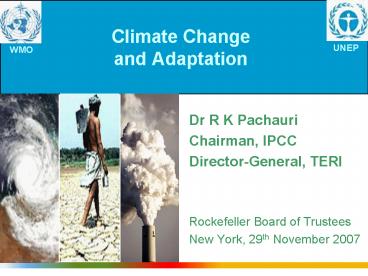Dr R K Pachauri - PowerPoint PPT Presentation
1 / 20
Title:
Dr R K Pachauri
Description:
... dependent communities and indigenous communities are ... communities in ... Vulnerable communities and regions. Vulnerability exacerbated by ... – PowerPoint PPT presentation
Number of Views:66
Avg rating:3.0/5.0
Title: Dr R K Pachauri
1
Climate Changeand Adaptation
UNEP
WMO
- Dr R K Pachauri
- Chairman, IPCC
- Director-General, TERI
- Rockefeller Board of Trustees
- New York, 29th November 2007
2
Climate change is unequivocal
- Warming of the climate system is unequivocal,
as is now evident from observations of increases
in global average air and ocean temperatures,
widespread melting of snow and ice, and rising
global average sea level
3
Climate change is unequivocal
Global average temperature
Global average sea level
Northern hemisphere snow cover
4
Climate change is unequivocal
5
Expected trends
- With current climate change mitigation policies
and related sustainable development practices,
global GHG emissions will continue to grow over
the next few decades
- Continued greenhouse gases emissions would induce
larger climatic changes than those observed in
20th century
6
Expected trends
- Anthropogenic warming could lead to some
impacts that are abrupt or irreversible,
depending upon the rate and magnitude of the
climate change
7
Vulnerable communities and regions
Vulnerable communities in the USA
- Economies of resource-dependent communities and
indigenous communities are particularly sensitive
to climate change
- In New Orleans during and after Hurricane
Katrina, the large majority of those requiring
evacuation assistance were either poor or in
groups - with limited mobility
8
Vulnerable communities and regions
Vulnerable regions
- Africa, Asia and Latin America have historically
been most at risk, and are most vulnerable to the
impacts of climate change
- Vulnerability exacerbated by existing stresses
- Endemic poverty
- Limited access to capital
- Ecosystem degradation
- Disasters and conflicts
- Failure of government system
- to respond effectively
9
Vulnerability of urban areas
- Most of the world population growth will take
place in cities, largely in Asia and Africa
- Urban population from 2000 to 2030
- 79 to 87 in North America
- 37 to 54 in Asia
- 54 of the world urban population expected to be
in Asia
Urbanization in high-risk areas is a special
concern, as it concentrates people and assets and
is generally increasing global and regional
vulnerability to climate-change impacts
10
Impacts on coastal areas
Coastal settlements most at risk
11
Impacts on coastal areas
- Many millions more people are projected to be
flooded every year due to sea-level rise by the
2080s
- The numbers affected will be largest in the
mega-deltas of Asia and Africa while small
islands are especially vulnerable
- Significant losses of coastal ecosystems will
affect the aquaculture industry
12
Impacts on agriculture
Increase or decrease
Cereal crop productivity Livestock
productivity Forestry production
13
Impacts on agriculture
- Agricultural productivity at low latitudes likely
to suffer severe losses because of - high temperature
- drought
- flood conditions
- soil degradation
- Possible yield reduction
- 50 by 2020 in some African countries
- 30 by 2050 in Central and South Asia
- 30 by 2080 in Latin America
14
Impacts on water stress
- Water availability significantly affected for
human consumption, agriculture and energy
generation due to - Changes in precipitation patterns
- Increasing salinity of groundwater due to
increases in sea level and over-exploitation - Glaciers melting decreasing river flows
- Ranges of people exposed to increased water
stress by 2020 - 120 millions to 1.2 billion in Asia
- 75 to 250 millions in Africa
- 12 to 81 millions in Latin America
15
Impacts on human health
- Increases in malnutrition and consequent disorders
- Increased burden of diarrhoeal disease
- Exacerbation of abundance and/or toxicity of
cholera due to increases in coastal water
temperature
- Increased deaths, disease and injury due to heat
waves, floods, storms, fires and droughts
- Increased frequency of cardio-respiratory diseases
16
Adaptation strategies
Need for adaptation
- Adaptation is necessary to address impacts
resulting from the warming which is already
unavoidable due to past emissions
- Adaptation is taking place through a range of
practices
- Adaptation capacity is limited and uneven across
and within societies
Climate change poses new risks that will require
new investments in adaptive responses
17
Adaptation strategies
- Enhancing social capital
- Protecting from sea level rise
- Increasing agriculture adaptive capacity
- Preventing water scarcity
Key need is to incorporate adaptation into
development policies and practices
18
Adaptation strategies
Beyond adaptation
- Adaptation alone is not expected to cope with all
the projected effects of climate change
- Impacts of climate change will increase as global
temperatures increase
Making development more sustainable can mitigate
GHG emissions, enhance adaptive capacity and
reduce vulnerability
19
Mitigation scenarios
Stabilization of GHGs at or above present levels
would not stabilize sea level for many centuries
1 The best estimate of climate sensitivity is
3ºC WG 1 SPM. 2 Note that global mean
temperature at equilibrium is different from
expected global mean temperature at the time of
stabilization of GHG concentrations due to the
inertia of the climate system. For the majority
of scenarios assessed, stabilisation of GHG
concentrations occurs between 2100 and 2150. 3
Ranges correspond to the 15th to 85th percentile
of the post-TAR scenario distribution. CO2
emissions are shown so multi-gas scenarios can be
compared with CO2-only scenarios.
20
Democracy must in essence therefore, mean the
art and science of mobilizing the entire
physical, economics and spiritual resources of
all the various sections of the people in the
service of the common good for all .































